#Antivaccination on Instagram: A Computational Analysis of Hashtag Activism through Photos and Public Responses
Abstract
1. Introduction
2. Related Works
2.1. Social Media Photos and Public Health
2.2. Hashtag Activism
2.3. Social Media Data Analysis on Antivaccination Movement
3. Method
3.1. Data Collection
3.2. Photo Features
3.2.1. Content Category
3.2.2. Face Features
3.2.3. Optical Character Recognition Features
3.2.4. Pixel Features
3.2.5. Visual Features
3.2.6. Engagement
3.2.7. Comment Sentiment
4. Results
4.1. The Content of Antivaccination Instagram Photos
4.2. Photo Features and Engagement of Antivaccination Instagram Photos
4.3. Photo Features and Comment Sentiment of Antivaccination Instagram Photos
5. Discussion
6. Conclusions
Author Contributions
Funding
Conflicts of Interest
References
- Bruns, A.; Stieglitz, S. Towards more systematic Twitter analysis: Metrics for tweeting activities. Int. J. Soc. 2013, 16, 91–108. [Google Scholar]
- Dadas, C. Hashtag activism: The promise and risk of “attention”. In Social Writing/Social Media: Publics, Presentations, Pedagogies; Walls, D.M., Vie, S., Eds.; The WAC Clearinghouse and University Press of Colorado: Fort Collins, CO, USA, 2018; pp. 17–36. [Google Scholar]
- Bruns, A.; Moon, B.; Paul, A.; Münch, F. Towards a typology of hashtag publics: A large-scale comparative study of user engagement across trending topics. Commun. Res. Pract. 2016, 2, 20–46. [Google Scholar] [CrossRef]
- Anderson, M.; Toor, S.; Rainie, L.; Smith, A. Activism in the Social Media Age; Pew Research Center: Washington, DC, USA, 2018. [Google Scholar]
- Crandall, H.; Cunningham, C.M. Media ecology and hashtag activism: Kaleidoscope. Explor. Media Ecol. 2016, 15, 21–32. [Google Scholar] [CrossRef]
- Kowald, D.; Lex, E. Studying confirmation bias in hashtag usage on Twitter. arXiv 2018, arXiv:1809.03203. Available online: https://arxiv.org/pdf/1809.03203.pdf (accessed on 17 October 2020).
- Lai, M.; Bosco, C.; Patti, V.; Virone, D. Debate on political reforms in Twitter: A hashtag-driven analysis of political polarization. In Proceedings of the 2015 IEEE International Conference on Data Science and Advanced Analytics (DSAA), Paris, France, 19–21 October 2015. [Google Scholar]
- Weber, I. Political polarization of web search queries and hashtags. SIGWEB Newsl. 2013, 56, 1–10. [Google Scholar] [CrossRef]
- Salathé, M.; Khandelwal, S. Assessing vaccination sentiments with online social media: Implications for infectious disease dynamics and control. PLoS Comput. Biol. 2011, 7, e1002199. [Google Scholar] [CrossRef] [PubMed]
- Radzikowski, J.; Stefanidis, A.; Jacobsen, K.H.; Croitoru, A.; Crooks, A.; Delamater, P.L. The Measles vaccination narrative in Twitter: A quantitative analysis. JMIR Public Health Surveill. 2016, 2, e1. [Google Scholar] [CrossRef] [PubMed]
- Jenkins, M.C.; Moreno, M.A. Vaccination discussion among parents on social media: A content analysis of comments on parenting blogs. J. Health Commun. 2020, 25, 232–242. [Google Scholar] [CrossRef] [PubMed]
- Fung, I.C.-H.; Blankenship, E.B.; Ahweyevu, J.O.; Cooper, L.K.; Duke, C.H.; Carswell, S.L.; Jackson, A.M.; Jenkins, J.C.; Duncan, E.A.; Liang, H.; et al. Public health implications of image-based social media: A systematic review of Instagram, Pinterest, Tumblr, and Flickr. Perm. J. 2020, 24, 307. [Google Scholar]
- Kim, Y.; Kim, J.H. Using photos for public health communication: A computational analysis of the Centers for Disease Control and Prevention Instagram photos and public responses. J. Health Inform. 2020, 26, 2159–2180. [Google Scholar] [CrossRef]
- Nobles, A.L.; Leas, E.C.; Noar, S.; Dredze, M.; Latkin, C.A.; Strathdee, S.A.; Ayers, J.W. Automated image analysis of Instagram posts: Implications for risk perception and communication in public health using a case study of #HIV. PLoS ONE 2020, 15, e0231155. [Google Scholar]
- Park, H.; Reber, B.H.; Chon, M.G. Tweeting as health communication: Health organizations’ use of Twitter for health promotion and public engagement. J. Health Commun. 2015, 21, 188–198. [Google Scholar] [CrossRef] [PubMed]
- Yi-Frazier, J.P.; Cochrane, K.; Mitrovich, C.; Pascual, M.; Buscaino, E.; Eaton, L.; Panlasigui, N.; Clopp, B.; Malik, F. Using Instagram as a modified application of photovoice for storytelling and sharing in adolescents with type 1 diabetes. Qual. Health Res. 2015, 25, 1372–1382. [Google Scholar] [CrossRef]
- Seltzer, E.K.; Horst-Martz, E.; Lu, M.; Merchant, R.M. Public sentiment and discourse about Zika virus on Instagram. Public Health 2017, 150, 170–175. [Google Scholar] [CrossRef]
- Fung, I.C.-H.; Blankenship, E.B.; Goff, M.E.; Mullican, L.A.; Chan, K.C.; Saroha, N.; Duke, C.H.; Eremeeva, M.E.; Fu, K.W.; Tse, Z.T.H. Zika-virus-related photo sharing on Pinterest and Instagram. Disaster Med. Public 2017, 11, 656–659. [Google Scholar] [CrossRef] [PubMed]
- Cho, H.; Silver, N.; Na, K.; Adams, D.; Luong, K.T.; Song, C. Visual cancer communication on social media: An examination of content and effects of #melanomasucks. J. Med. Internet Res. 2018, 20, e10501. [Google Scholar] [PubMed]
- Chu, K.H.; Allem, J.P.; Cruz, T.B.; Unger, J.B. Vaping on Instagram: Cloud chasing, hand checks and product placement. Tob. Control 2016, 26, 575–578. [Google Scholar] [CrossRef]
- Lee, A.S.; Hart, J.L.; Sears, C.G.; Walker, K.L.; Siu, A.; Smith, C. A picture is worth a thousand words: Electronic cigarette content on Instagram and Pinterest. Tob. Prev. Cessation 2017, 3, 119. [Google Scholar] [CrossRef]
- Laestadius, L.I.; Wahl, M.M.; Cho, Y.I. #Vapelife: An exploratory study of electronic cigarette use and promotion on Instagram. Subst. Use Misuse 2016, 51, 1669–1673. [Google Scholar]
- Allem, J.P.; Escobedo, P.; Chu, K.H.; Boley Cruz, T.; Unger, J.B. Images of little cigars and cigarillos on Instagram identified by the hashtag #swisher: Thematic analysis. J. Med. Internet Res. 2017, 19, e255. [Google Scholar]
- Cohen, R.; Irwin, L.; Newton-John, T.; Slater, A. #bodypositivity: A content analysis of body positive accounts on Instagram. Body Image 2019, 29, 47–57. [Google Scholar] [PubMed]
- Pilgrim, K.; Bohnet-Joschko, S. Selling health and happiness how influencers communicate on Instagram about dieting and exercise: Mixed methods research. BMC Public Health 2019, 19, 1054. [Google Scholar] [CrossRef]
- Brown, R.C.; Fischer, T.; Goldwich, A.D.; Keller, F.; Young, R.; Plener, P.L. #cutting: Non-suicidal self-injury (NSSI) on Instagram. Psychol. Med. 2018, 48, 337–346. [Google Scholar]
- Fulcher, J.A.; Dunbar, S.; Orlando, E.; Woodruff, S.J.; Santarossa, S. #selfharn on Instagram: Understanding online communities surrounding non-suicidal self-injury through conversations and common properties among authors. Digital Health 2020, 6. [Google Scholar] [CrossRef]
- Hendriks, H.; Van den Putte, B.; Gebhardt, W.A.; Moreno, M.A. Social drinking on social media: Content analysis of the social aspects of alcohol-related posts on Facebook and Instagram. J. Med. Internet Res. 2018, 20, e226. [Google Scholar] [CrossRef]
- Vassallo, A.J.; Kelly, B.; Zhang, L.; Wang, Z.; Young, S.; Freeman, B. Junk food marketing on Instagram: Content analysis. JMIR Public Health Surveill. 2018, 4, e54. [Google Scholar] [CrossRef]
- Oviatt, J.R.; Reich, S.M. Pregnancy posting: Exploring characteristics of social media posts around pregnancy and user engagement. mHealth 2019, 5, 46. [Google Scholar] [CrossRef] [PubMed]
- Buyuk, S.K.; Imamoglu, T. Instagram as a social media tool about orthognathic surgery. Health Promot. Perspect. 2019, 9, 319–322. [Google Scholar] [CrossRef] [PubMed]
- Bonilla, Y.; Rosa, J. #Ferguson: Digital protest, hashtag ethnography, and the racial politics of social media in the United States. Am. Ethnol. 2015, 42, 4–17. [Google Scholar]
- Yang, G. Narrative agency in hashtag activism: The case of #BlackLivesMatter. Media Commun. 2016, 4, 13–17. [Google Scholar]
- Clark, R. “Hope in a hashtag”: The discursive activism of #WhyIStayed. Fem. Media Stud. 2016, 16, 788–804. [Google Scholar]
- Kim, J. #iamafeminist as the “mother tag”: Feminist identification and activism against misogyny on Twitter in South Korea. Fem. Media Stud. 2017, 17, 804–820. [Google Scholar]
- Fischer, M. #Free_CeCe: The material convergence of social media activism. Fem. Media Stud. 2016, 16, 755–771. [Google Scholar]
- Ramírez, B.G.; Metcalfe, A.S. Hashtivism as public discourse: Exploring online student activism in response to state violence and forced disappearances in Mexico. Res. Educ. 2017, 97, 56–75. [Google Scholar] [CrossRef]
- Krutka, D.G.; Asino, T.I.; Haselwood, S. Editorial: Eight lessons on networked teacher activism from #OklaEd and the #OklaEdWalkout. CITE 2018, 18, 379–391. [Google Scholar]
- Papacharissi, Z.; de Fatima Oliveira, M. Affective news and networked publics: The rhythms of news storytelling on #Egypt. J. Commun. 2012, 62, 266–282. [Google Scholar]
- Giglietto, F.; Lee, Y. A hashtag worth a thousand words: Discursive strategies around #JeNeSuisPasCharlie after the 2015 Charlie Hebdo shooting. SM+S 2017, 3. [Google Scholar] [CrossRef]
- Brown, M.; Ray, R.; Summers, E.; Fraistat, N. #SayHerName: A case study of intersectional social media activism. Ethn. Racial Stud. 2017, 40, 1831–1846. [Google Scholar]
- Xiong, Y.; Cho, M.; Boatwright, B. Hashtag activism and message frames among social movement organizations: Semantic network analysis and thematic analysis of Twitter during the #MeToo movement. Public Relat. Rev. 2019, 45, 10–23. [Google Scholar]
- Ince, J.; Rojas, F.; Davis, C.A. The social media response to Black Lives Matter: How Twitter users interact with Black Lives Matter through hashtag use. Ethn. Racial Stud. 2017, 40, 1814–1830. [Google Scholar] [CrossRef]
- Ray, R.; Brown, M.; Fraistat, N.; Summers, E. Ferguson and the death of Michael Brown on Twitter: #BlackLivesMatter, #TCOT, and the evolution of collective identities. Ethn. Racial Stud. 2017, 40, 1797–1813. [Google Scholar]
- Drüeke, R.; Zobl, E. Online feminist protest against sexism: The German-language hashtag #aufschrei. Fem. Media Stud. 2016, 16, 35–54. [Google Scholar]
- Xu, W.W.; Sang, Y.; Blasiola, S.; Park, H.W. Predicting opinion leaders in Twitter activism networks. Am. Behav. Sci. 2014, 58, 1278–1293. [Google Scholar] [CrossRef]
- Jackson, S.J.; Foucault Welles, B. #Ferguson is everywhere: Initiators in emerging counterpublic networks. Inf. Commun. Soc. 2016, 19, 397–418. [Google Scholar]
- Yan, G.; Pegoraro, A.; Watanabe, N.M. Student-athletes’ organization of activism at the University of Missouri: Resource mobilization on Twitter. J. Sport Manag. 2018, 32, 24–37. [Google Scholar] [CrossRef]
- Wang, R.; Liu, W.; Gao, S. Hashtags and information virality in networked social movement. Online Inf. Rev. 2016, 40, 850–866. [Google Scholar] [CrossRef]
- Tremayne, M. Anatomy of protest in the digital era: A network analysis of Twitter and Occupy Wall Street. Soc. Mov. Stud. 2014, 13, 110–126. [Google Scholar] [CrossRef]
- Stefanone, M.A.; Saxton, G.D.; Egnoto, M.J.; Wei, W.; Fu, Y. Image attributes and diffusion via Twitter: The case of #guncontrol. In Proceedings of the 48th Hawaii International Conference on System Sciences, Kauai, HI, USA, 5–8 January 2015; pp. 1788–1797. [Google Scholar]
- Ichau, E.; Frissen, T.; d’Haenens, L. From #selfie to #edgy. Hashtag networks and images associated with the hashtag #jews on Instagram. Telemat. Inform. 2019, 44, 101275. [Google Scholar]
- Witteman, H.O.; Zikmund-Fisher, B.J. The defining characteristics of Web 2.0 and their potential influence in the online vaccination debate. Vaccine 2012, 30, 3734–3740. [Google Scholar] [CrossRef]
- Connolly, T.; Reb, J. Toward interactive, Internet-based decision aid for vaccination decisions: Better information alone is not enough. Vaccine 2012, 30, 3813–3818. [Google Scholar] [CrossRef]
- Betsch, C.; Brewer, N.T.; Brocard, P.; Davies, P.; Gaissmaier, W.; Haase, N.; Leask, J.; Renkewitz, F.; Renner, B.; Reyna, V.F.; et al. Opportunities and challenges of Web 2.0 for vaccination decisions. Vaccine 2012, 30, 3727–3733. [Google Scholar] [CrossRef]
- Meppelink, C.S.; Smit, E.G.; Fransen, M.L.; Diviani, N. “I was right about vaccination”: Confirmation bias and health literacy in online health information seeking. J. Health Commun. 2019, 24, 129–140. [Google Scholar] [CrossRef]
- Amicizia, D.; Domnich, A.; Gasparini, R.; Bragazzi, N.L.; Lai, P.L.; Panatto, D. An overview of current and potential use of information and communication technologies for immunization promotion among adolescents. Hum. Vaccines Immunother. 2013, 9, 2634–2642. [Google Scholar] [CrossRef] [PubMed]
- Keelan, J.; Pavri, V.; Balakrishnan, R.; Wilson, K. An analysis of the Human Papilloma Virus vaccine debate on MySpace blogs. Vaccine 2010, 28, 1535–1540. [Google Scholar] [CrossRef]
- Broniatowski, D.A.; Jamison, A.M.; Qi, S.; AlKulaib, L.; Chen, T.; Benton, A.; Quinn, S.C.; Dredze, M. Weaponized health communication: Twitter bots and Russian trolls amplify the vaccine debate. Am. J. Public Health 2018, 108, 1378–1384. [Google Scholar] [CrossRef] [PubMed]
- Jang, S.M.; Mckeever, B.W.; Mckeever, R.; Kim, J.K. From social media to mainstream news: The information flow of the vaccine-autism controversy in the US, Canada, and the UK. Health Commun. 2019, 34, 110–117. [Google Scholar] [CrossRef]
- Yuan, X.; Schuchard, R.J.; Crooks, A.T. Examining emergent communities and social bots within the polarized online vaccination debate in Twitter. SM+S 2019, 5. [Google Scholar] [CrossRef]
- Himelboim, I.; Xiao, X.; Lee, D.K.L.; Wang, M.Y.; Borah, P. A social networks approach to understanding vaccine conversations on Twitter: Network clusters, sentiment, and certainty in HPV social networks. Health Commun. 2020, 35, 607–615. [Google Scholar] [CrossRef] [PubMed]
- Johnson, N.F.; Velásquez, N.; Restrepo, N.J.; Leahy, R.; Gabriel, N.; El Oud, S.; Zheng, M.; Manrique, P.; Wuchty, S.; Lupu, Y. The online competition between pro- and anti-vaccination views. Nature 2020, 582, 230–233. [Google Scholar] [CrossRef]
- Francia, M.; Gallinucci, E.; Golfarelli, M. Social BI to understand the debate on vaccines on the Web and social media: Unraveling the anti-, free, and pro-vax communities in Italy. SNAM 2019, 9, 46. [Google Scholar] [CrossRef]
- Smith, N.; Graham, T. Mapping the anti-vaccination movement on Facebook. Inf. Commun. Soc. 2019, 22, 1310–1327. [Google Scholar] [CrossRef]
- Guidry, J.P.; Carlyle, K.; Messner, M.; Jin, Y. On pins and needles: How vaccines are portrayed on Pinterest. Vaccine 2015, 33, 5051–5056. [Google Scholar] [CrossRef] [PubMed]
- Kearney, M.D.; Selvan, P.; Hauer, M.K.; Leader, A.E.; Massey, P.M. Characterizing HPV vaccine sentiments and content on Instagram. Health Educ. Behav. 2019, 46, 37S–48S. [Google Scholar] [CrossRef]
- Chen, T.; Dredze, M. Vaccine images on Twitter: Analysis of what images are shared. J. Med. Internet Res. 2018, 20, e130. [Google Scholar] [CrossRef] [PubMed]
- Del Sole, A. Microsoft Computer Vision APIs Distilled: Getting Started with Cognitive Services; Apress: Berkeley, CA, USA, 2018. [Google Scholar]
- Bradski, G. The OpenCV library. DDJST 2000, 120, 122–125. [Google Scholar]
- Kim, Y.; Kim, J.H. Using computer vision techniques on Instagram to link users’ personalities and genders to the features of their photos: An exploratory study. Inform. Process Manag. 2018, 54, 1101–1114. [Google Scholar] [CrossRef]
- Ke, Y.; Tang, X.; Jing, F. The design of high-level features for photo quality assessment. In Proceedings of the 2006 IEEE Computer Society Conference on Computer Vision and Pattern Recognition, New York, NY, USA, 17–22 June 2006; pp. 419–426. [Google Scholar]
- Mao, X.; Chen, B.; Muta, I. Affective property of image and fractal dimension. Chaos Soliton Fract. 2003, 15, 905–910. [Google Scholar] [CrossRef]
- Valdez, P.; Mehrabian, A. Effects of color on emotions. J. Exp. 1994, 123, 394–409. [Google Scholar] [CrossRef]
- San Pedro, J.; Siersdorfer, S. Ranking and classifying attractiveness of photos in folksonomies. In Proceedings of the 18th international conference on World Wide Web (WWW ‘09), Madrid, Spain, 20–24 April 2009; pp. 771–780. [Google Scholar]
- Hasler, D.; Süsstrunk, S. Measuring colorfulness in natural images. In Human Vision and Electronic Imaging VIII; Rogowitz, B.E., Pappas, T.N., Eds.; International Society for Optics and Photonics: Bellingham, WA, USA, 2003; pp. 87–95. [Google Scholar]
- Huang, K.Q.; Wang, Q.; Wu, Z.Y. Natural color image enhancement and evaluation algorithm based on human visual system. Comput. Vis. Image Underst. 2006, 103, 52–63. [Google Scholar] [CrossRef]
- Savakis, A.E.; Etz, S.P.; Loui, A.C. Evaluation of image appeal in consumer photography. In Human Vision and Electronic Imaging V; Rogowitz, B.E., Pappas, T.N., Eds.; SPIE–IS&T: San Jose, CA, USA, 2000; pp. 110–120. [Google Scholar]
- Feng, J.; Lin, W.C.; Chen, C.T. Fractional box-counting approach to fractal dimension estimation. In Proceedings of the 13th International Conference on Pattern Recognition, Vienna, Austria, 25–29 August 1996; pp. 854–858. [Google Scholar]
- Kim, D.; Son, S.W.; Jeong, H. Large-scale quantitative analysis of painting arts. Sci. Rep. 2014, 4, 7370. [Google Scholar] [CrossRef]
- Moon, P.; Spencer, D.E. Geometric formulation of classical color harmony. J. Opt. Soc. Am. B 1944, 34, 46. [Google Scholar] [CrossRef]
- Datta, R.; Joshi, D.; Li, J.; Wang, J.Z. Studying aesthetics in photographic images using a computational approach. In Computer Vision: ECCV 2006; Leonardis, A., Bischof, H., Pinz, A., Eds.; Springer: Berlin/Heidelberg, Germany, 2006; pp. 288–301. [Google Scholar]
- Neiger, B.L.; Thackeray, R.; Van Wagenen, S.A.; Hanson, C.L.; West, J.H.; Barnes, M.D.; Fagen, M.C. Use of social media in health promotion: Purposes, key performance indicators, and evaluation metrics. Health Promot. Pract. 2012, 13, 159–164. [Google Scholar] [CrossRef] [PubMed]
- Zinoviev, D. Complex Network Analysis in Python; Pragmatic Bookshelf: Raleigh, NC, USA, 2018. [Google Scholar]
- Bientzle, M.; Griewatz, J.; Kimmerle, J.; Küppers, J.; Cress, U.; Lammerding-Koeppel, M. Impact of scientific versus emotional wording of patient questions on doctor-patient communication in an internet forum: A randomized controlled experiment with medical students. J. Med. Internet Res. 2015, 17, e268. [Google Scholar] [CrossRef]
- Kimmerle, J.; Bientzle, M.; Cress, U. “Scientific evidence is very important for me”: The impact of behavioral intention and the wording of user inquiries on replies and recommendations in a health-related online forum. Comput. Hum. Behav. 2017, 73, 320–327. [Google Scholar] [CrossRef]
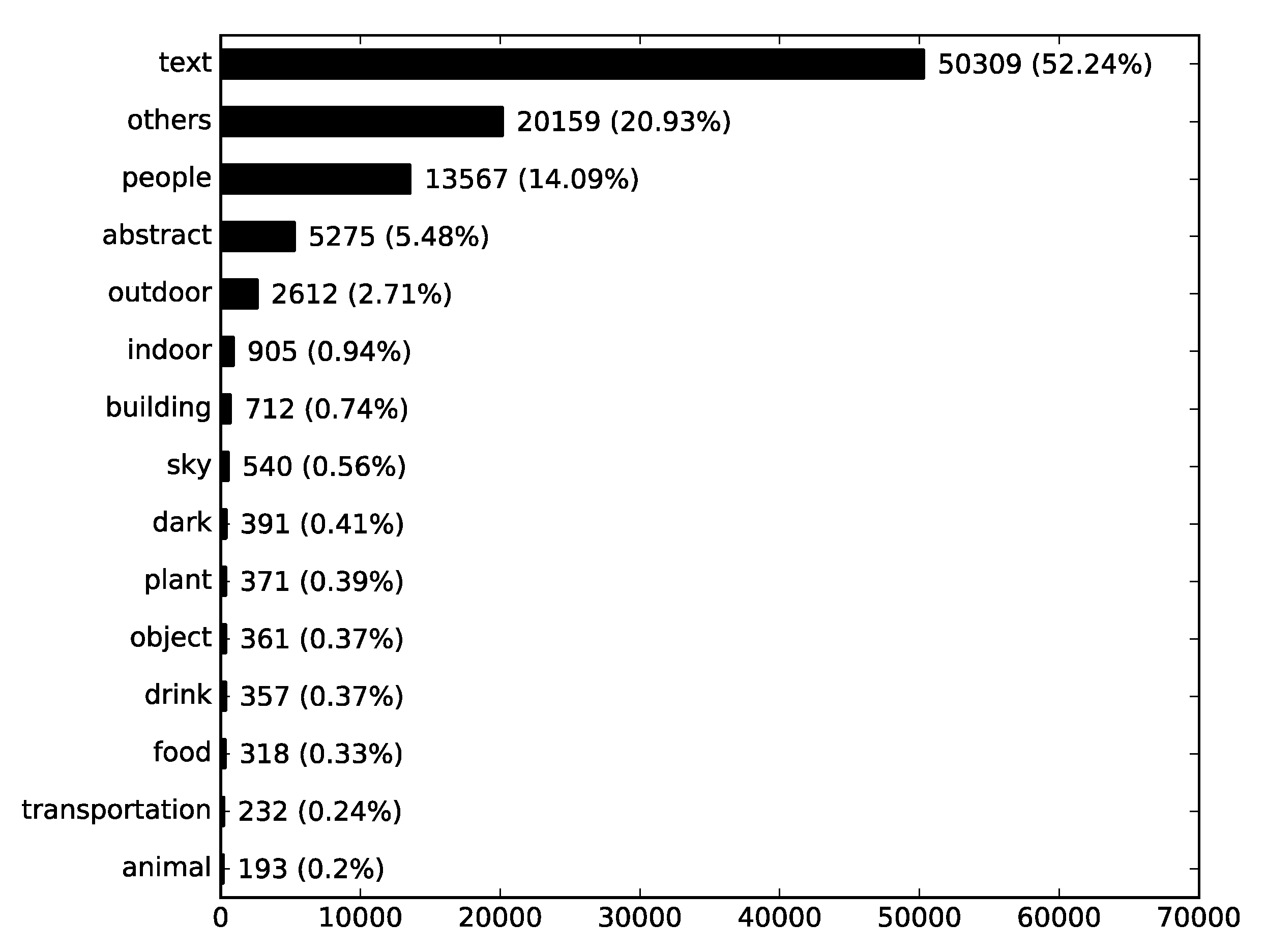
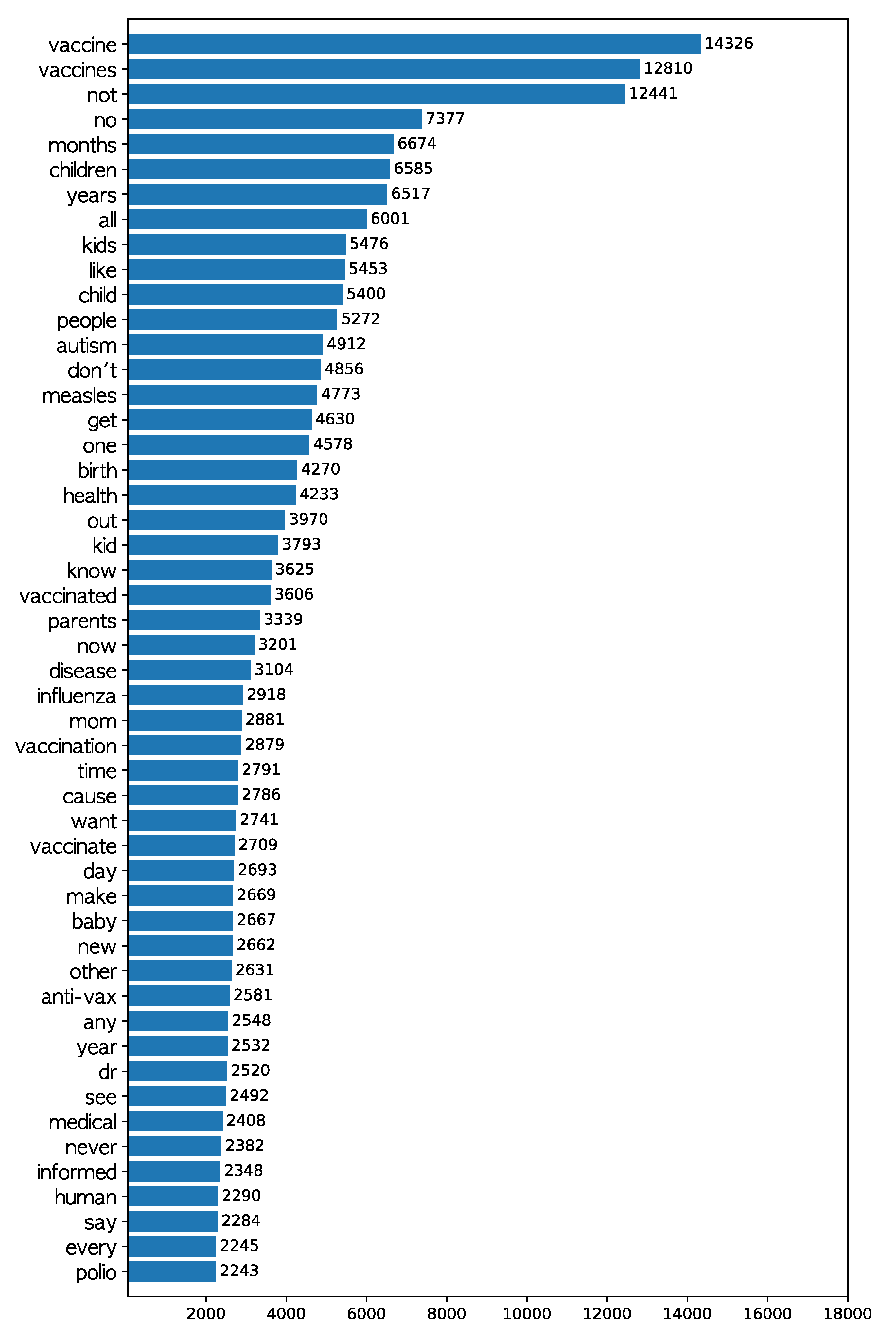

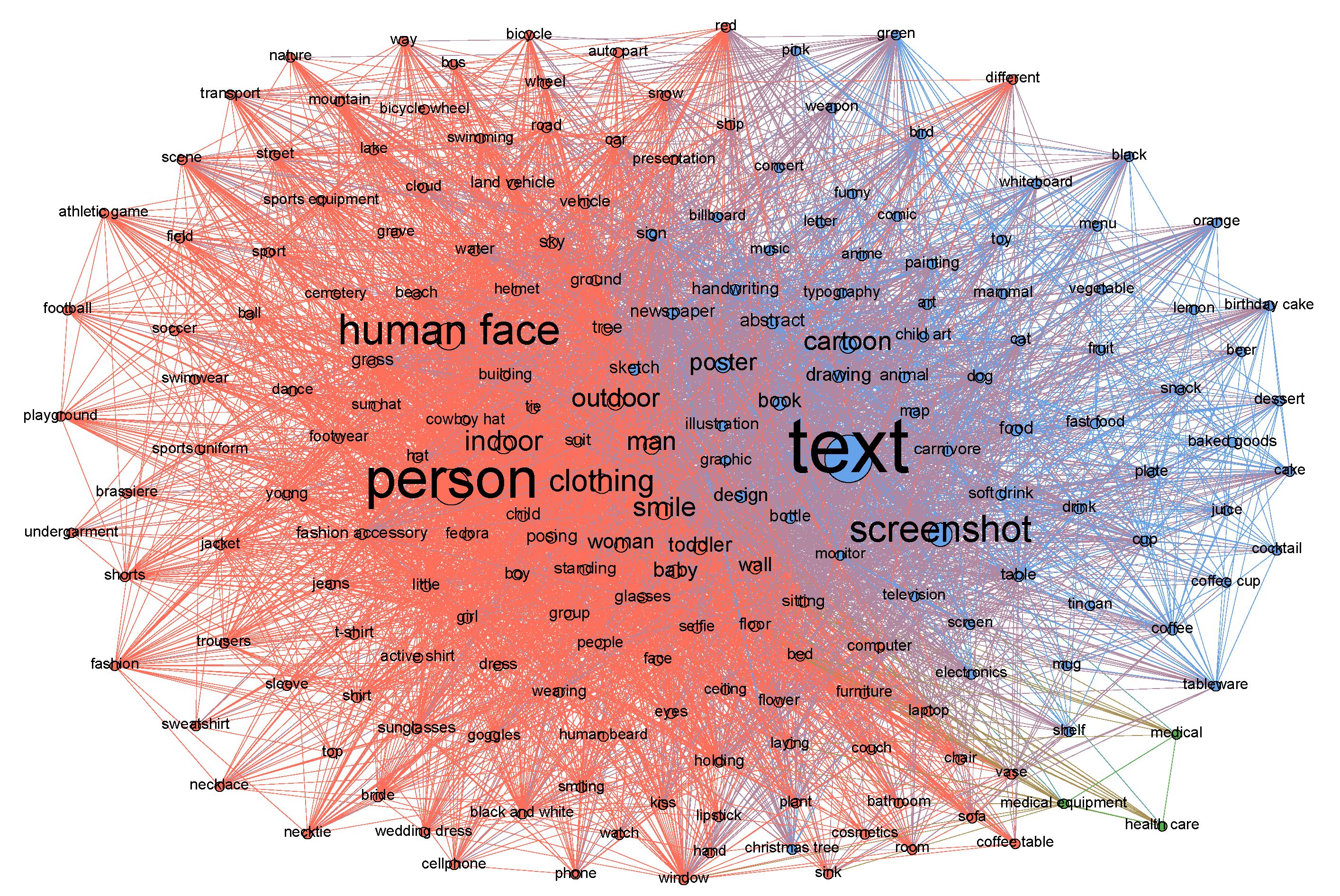
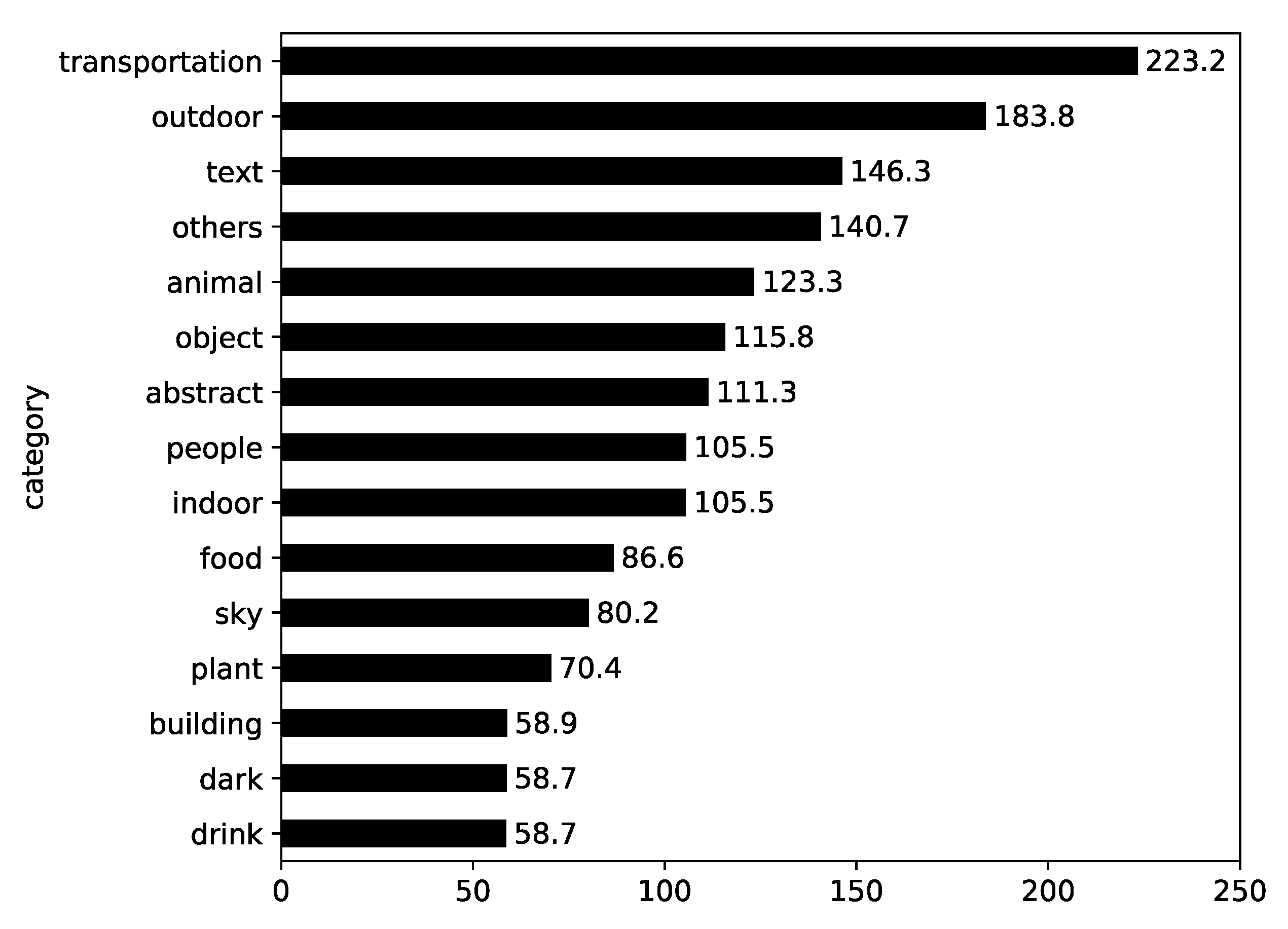
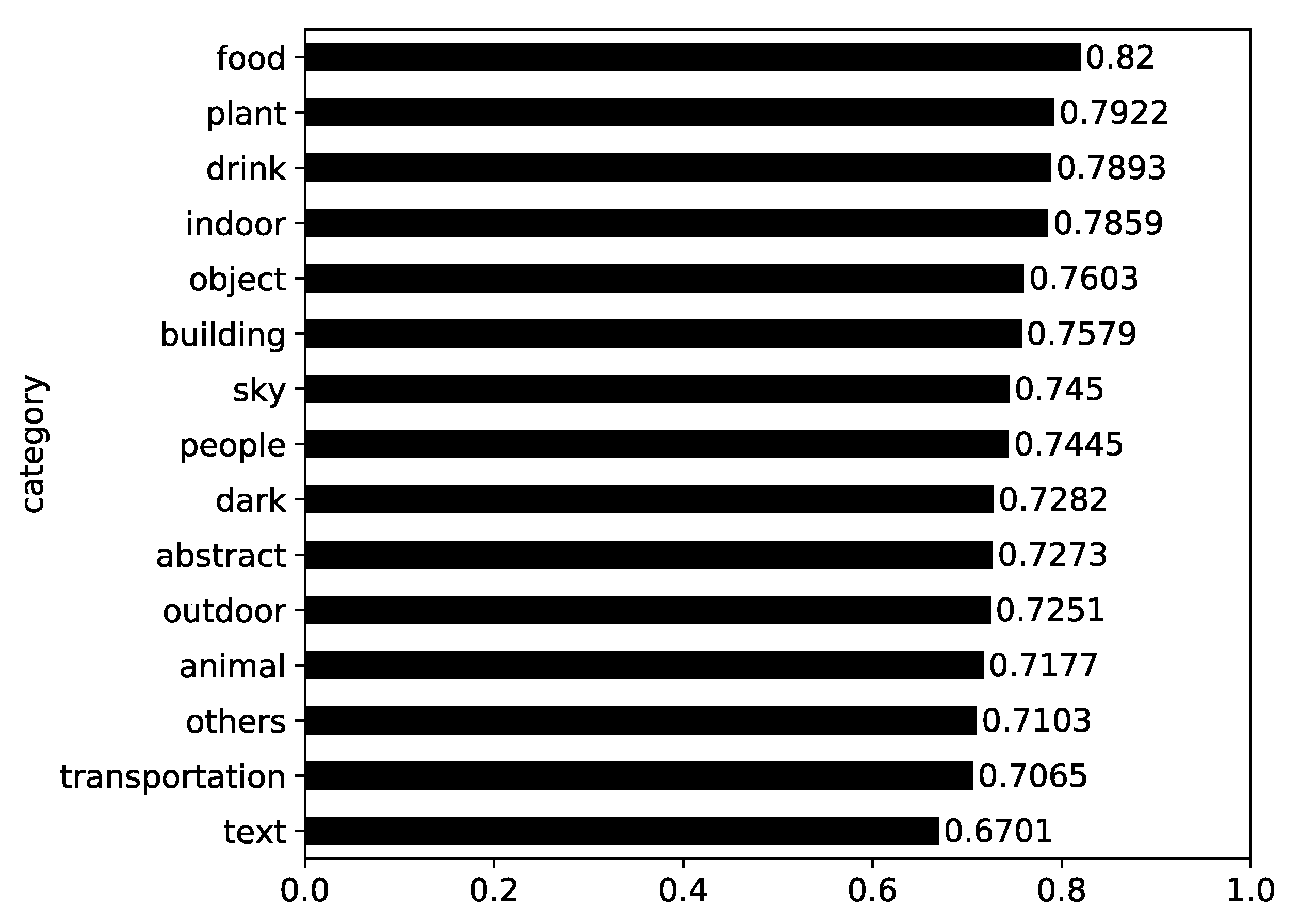
| Ranking | Weighted Degree | Betweenness | Closeness | Eigenvector |
|---|---|---|---|---|
| 1 | text | text | text | text |
| 2 | person | person | person | person |
| 3 | human face | indoor | indoor | indoor |
| 4 | screenshot | outdoor | outdoor | outdoor |
| 5 | clothing | food | clothing | clothing |
| 6 | indoor | clothing | wall | human face |
| 7 | smile | screenshot | food | wall |
| 8 | cartoon | wall | screenshot | man |
| 9 | outdoor | animal | human face | screenshot |
| 10 | man | floor | ground | woman |
| 11 | poster | ground | sky | ground |
| 12 | woman | table | man | smile |
| 13 | toddler | sky | floor | sky |
| 14 | baby | fashion accessory | woman | tree |
| 15 | book | grass | grass | grass |
| 16 | wall | human face | tree | floor |
| 17 | drawing | tree | table | book |
| 18 | design | cartoon | smile | sitting |
| 19 | abstract | man | book | cartoon |
| 20 | tree | woman | cartoon | toddler |
| 21 | grass | camera | sitting | table |
| 22 | posing | fruit | water | food |
| 23 | sky | plant | toddler | baby |
| 24 | newspaper | water | baby | building |
| 25 | sketch | cup | animal | fashion accessory |
| 26 | food | design | building | poster |
| 27 | handwriting | book | fashion accessory | girl |
| 28 | animal | sport | poster | holding |
| 29 | child | plate | holding | child |
| 30 | bottle | fast food | design | water |
| Theme | Words |
|---|---|
| text and joy | text, screenshot, cartoon, poster, book, drawing, design, abstract, newspaper, sketch, food, handwriting, animal, bottle, sign, table, carnivore, illustration, child art, dog, soft drink, art, cup, graphic, drink, painting, fast food, mammal, typography, plate, cat, fruit, baked goods, coffee, map, snack, dessert, toy, monitor, billboard, music, cake, bird, letter, tableware, television, vegetable, funny, birthday cake, anime, weapon, green, juice, whiteboard, screen, black, menu, orange, concert, comic, pink, electronics, cocktail, lemon, coffee cup, shelf, tin can, mug, beer, Christmas tree |
| personal and indoor life | person, human face, clothing, indoor, smile, outdoor, man, woman, toddler, baby, wall, tree, grass, posing, sky, child, ground, standing, floor, fashion accessory, suit, glasses, sitting, vehicle, boy, land vehicle, car, water, group, hat, girl, building, little, face, people, footwear, furniture, bed, computer, road, holding, tie, wearing, wheel, selfie, dress, fedora, young, beach, flower, active shirt, eyes, cowboy hat, jeans, sunglasses, t-shirt, shirt, ceiling, black and white, sleeve, couch, laptop, chair, sports equipment, snow, sun hat, kiss, window, plant, vase, dance, goggles, wedding dress, cloud, jacket, swimming, trousers, smiling, presentation, sofa, laying, sport, sports uniform, bride, mountain, auto part, bicycle, helmet, swimwear, soccer, ball, field, shorts, bicycle wheel, ship, red, nature, lake, top, street, fashion, bathroom, lipstick, cellphone, football, brassiere, hand, room, athletic game, phone, scene, different, sink, sweatshirt, playground, human beard, coffee table, watch, grave, way, cemetery, transport, undergarment, bus, necktie, necklace, cosmetics |
| medical | medical equipment, medical, health care |
| Kind | Feature | Like | Comment | Engagement |
|---|---|---|---|---|
| Face features | Number of faces | 0.003 | 0.005 | 0.003 |
| Closeup | −0.005 | 0.011 * | −0.005 | |
| Face ratio | −0.006 | 0.010 * | −0.006 | |
| Age | 0.008 * | −0.001 | 0.008 * | |
| Female | −0.001 | 0.014 * | 0.000 | |
| Anger | −0.001 | −0.005 | −0.001 | |
| Contempt | 0.004 | 0.004 | 0.004 | |
| Disgust | 0.001 | 0.008 * | 0.002 | |
| Fear | 0.000 | −0.002 | 0.000 | |
| Happiness | −0.005 | 0.008 * | −0.005 | |
| Sadness | −0.002 | 0.007 * | −0.002 | |
| Surprise | 0.002 | 0.002 | 0.002 | |
| Neutral | 0.021 * | 0.010 * | 0.021 * | |
| OCR feature | Number of words | 0.011 * | 0.035 * | 0.012 * |
| Pixel features | Red mean | 0.024 * | 0.021 * | 0.025 * |
| Red var | −0.004 | −0.013 * | −0.004 | |
| Green mean | 0.028 * | 0.023 * | 0.028 * | |
| Green var | 0.001 | −0.011 * | 0.000 | |
| Blue mean | 0.027 * | 0.025 * | 0.028 * | |
| Blue var | 0.008 * | −0.009 * | 0.008 * | |
| Saturation mean | −0.028 * | −0.030 * | −0.028 * | |
| Saturation var | −0.007 * | −0.025 * | −0.008 * | |
| Value mean | 0.020 * | 0.018 * | 0.020 * | |
| Value var | −0.001 | −0.007 * | −0.001 | |
| Red share | −0.010 * | −0.004 | −0.010 * | |
| Orange share | −0.021 * | −0.010 * | −0.021 * | |
| Yellow share | −0.014 * | −0.011 * | −0.014 * | |
| Green share | −0.020 * | −0.023 * | −0.021 * | |
| Blue share | −0.012 * | −0.008 * | −0.012 * | |
| Violet share | - | - | - | |
| Share of warm colors | −0.025 * | −0.014 * | −0.025 * | |
| Share of cold colors | −0.023 * | −0.021 * | −0.023 * | |
| Hue peaks | −0.003 | −0.015 * | −0.003 | |
| Pleasure | 0.013 * | 0.010 * | 0.013 * | |
| Arousal | −0.030 * | −0.031 * | −0.031 * | |
| Dominance | −0.026 * | −0.025 * | −0.026 * | |
| Visual features | Brightness | 0.027 * | 0.024 * | 0.028 * |
| Colorfulness | −0.022 * | −0.028 * | −0.022 * | |
| Naturalness | 0.000 | −0.009 * | 0.000 | |
| Contrast | 0.006 | −0.004 | 0.006 | |
| RGB Contrast | 0.001 | −0.010 * | 0.001 | |
| Sharpness | −0.005 | 0.020 * | −0.005 | |
| Color diversity | 0.008 * | −0.021 * | 0.007 * | |
| Color harmony | 0.011 * | −0.004 | 0.011 * |
| Feature | Like | Comment | Engagement |
|---|---|---|---|
| Face features | 10.368 | 2.249 | 10.584 |
| OCR feature | 10.366 | 2.25 | 10.582 |
| Pixel features | 10.363 | 2.249 | 10.580 |
| Visual features | 10.355 | 2.248 | 10.572 |
| All features | 10.352 | 2.245 | 10.568 |
| Kind | Feature | Sentiment |
|---|---|---|
| Face features | Number of faces | 0.020 * |
| Closeup | 0.002 | |
| Face ratio | 0.005 | |
| Age | 0.011 * | |
| Female | 0.037 * | |
| Anger | 0.004 | |
| Contempt | −0.008 | |
| Disgust | −0.012 * | |
| Fear | −0.011 * | |
| Happiness | 0.046 * | |
| Sadness | −0.023 * | |
| Surprise | −0.016 * | |
| Neutral | −0.027 * | |
| OCR feature | Number of words | −0.129 * |
| Pixel features | Red mean | −0.046 * |
| Red var | −0.028 * | |
| Green mean | −0.056 * | |
| Green var | −0.040 * | |
| Blue mean | −0.066 * | |
| Blue var | −0.044 * | |
| Saturation mean | 0.059 * | |
| Saturation var | 0.006 | |
| Value mean | −0.044 * | |
| Value var | −0.026 * | |
| Red share | 0.024 * | |
| Orange share | 0.074 * | |
| Yellow share | 0.038 * | |
| Green share | 0.054 * | |
| Blue share | −0.005 | |
| Violet share | - | |
| Share of warm colors | 0.081 * | |
| Share of cold colors | 0.028 * | |
| Hue peaks | 0.017 * | |
| Pleasure | −0.030 * | |
| Arousal | 0.066 * | |
| Dominance | 0.057 * | |
| Visual features | Brightness | −0.056 * |
| Colorfulness | 0.037 * | |
| Naturalness | 0.027 * | |
| Contrast | −0.046 * | |
| RGB Contrast | −0.040 * | |
| Sharpness | 0.021 * | |
| Color diversity | 0.041 * | |
| Color harmony | −0.011 * |
| Feature | Comment Sentiment |
|---|---|
| Face features | 0.451 |
| OCR feature | 0.447 |
| Pixel features | 0.448 |
| Visual features | 0.448 |
| All features | 0.432 |
Publisher’s Note: MDPI stays neutral with regard to jurisdictional claims in published maps and institutional affiliations. |
© 2020 by the authors. Licensee MDPI, Basel, Switzerland. This article is an open access article distributed under the terms and conditions of the Creative Commons Attribution (CC BY) license (http://creativecommons.org/licenses/by/4.0/).
Share and Cite
Kim, Y.; Song, D.; Lee, Y.J. #Antivaccination on Instagram: A Computational Analysis of Hashtag Activism through Photos and Public Responses. Int. J. Environ. Res. Public Health 2020, 17, 7550. https://doi.org/10.3390/ijerph17207550
Kim Y, Song D, Lee YJ. #Antivaccination on Instagram: A Computational Analysis of Hashtag Activism through Photos and Public Responses. International Journal of Environmental Research and Public Health. 2020; 17(20):7550. https://doi.org/10.3390/ijerph17207550
Chicago/Turabian StyleKim, Yunhwan, Donghwi Song, and Yeon Ju Lee. 2020. "#Antivaccination on Instagram: A Computational Analysis of Hashtag Activism through Photos and Public Responses" International Journal of Environmental Research and Public Health 17, no. 20: 7550. https://doi.org/10.3390/ijerph17207550
APA StyleKim, Y., Song, D., & Lee, Y. J. (2020). #Antivaccination on Instagram: A Computational Analysis of Hashtag Activism through Photos and Public Responses. International Journal of Environmental Research and Public Health, 17(20), 7550. https://doi.org/10.3390/ijerph17207550






